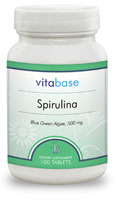| |
Spirulina |
|
| Spirulina is a genus of filamentous cyanobacteria (commonly called blue-green algae). Spirulina is the common name given to the variety of blue-green algae Spirulina platenis. The name spirulina is derived from the Latin word for spiral and describes the microalgae's cell structure of spiralling filaments. Spirulina is a type of blue-green algae found in most lakes and ponds. Spirulina is a photosynthetic, filamentous, spiral-shaped, multicellular and green-blue microalg. The organism thrives in fresh water ponds and lakes that are considerably more alkaline than average. Spirulina is a very rich source of nutrition. This nutrient rich herb is often hailed as a wonder food for many aspects of health and diet. |
| |
Active constituents of spirulina |
|
| Spirulina is considered a complete protein because it consists of all of the essential amino acids (isoleucine, phenylalanine, leucine, threonine, lysine, tryptophan, methionine, valine, alanine, glycine, arginine, histidine, aspartic acid, proline, cystine, serine, glutamic acid, tyrosine). It is a rich source of vitamins (vitamin A, thiamine, riboflavin, niacin, pyridoxine, cobalamin, vitamin C, vitamin D, vitamin E, folate, vitamin K, biotin, pantothenic acid, beta carotene, inositol), and minerals (calcium, manganese, iron, chromium, phosphorus, molybdenum, iodine, chloride, magnesium, sodium, zinc, potassium, selenium, germanium, copper, boron). Other nutrients include chlorophyll, carotenoids, gamma-linolenic acid (GLA), phycobilins (phycocyanin, allophycocyanin). High in nutrition but low in calories, spirulina is only 7 percent lipid, made up of linoleic, linolenic and arachidonic acids. |
| |
Medicinal uses and health benefits of spirulina |
|
|
Spirulina is a low fat, low calorie, cholesterol-free source of protein containing all the essential amino acids. Spirulina has shown the ability to enhance immune function. Spirulina promotes hematopoiesis (formation and development of red blood cells) due to the high levels of iron present in this food supplement. Spirulina may protect against allergic reactions by blocking the release of histamines. By blocking histamine release, spirulina may prevent or lessen histamine's effects, which include blood vessel expansion, muscle contraction, and stomach acid production. Spirulina contains beta carotene, zeaxanthin and phycocyanin which have powerfful antioxidant activity. It scavenges peroxyl radicals. Antioxidants are thought to protect body cells from damage caused by a chemical process called oxidation. Both the antioxidant and immune-enhancing effects of spirulina may give it some anticancer properties. Spirulina increases production of antibodies, cytokines (infection fighting proteins), and other cells that improve immunity and help ward off infection and chronic illnesses such as cancer. Spirulina may help protect against liver damage and cirrhosis (liver failure) in those with chronic hepatitis. Gamma linolenic acid (GLA) in spirulina is anti-inflammatory and antiproliferative. It is potentially useful for individuals with rheumatoid arthritis and diabetic neuropathy. It may also play a role in lowering plasma triglycerides and increasing HDL cholesterol. |
| |
Dosage and administration of spirulina |
|
| Spirulina is available in capsules, tablets, flakes and powders. Typical doses of spirulina range from 250 mg to 5 grams daily per day. A dose of one gram (in capsules/tablets) twice daily with meals has been taken by mouth has been used to fight diabetes. For weight loss, a dose of 200 mg has been taken three times daily by mouth just before meals. |
| |
Side effects, precautions, interactions |
|
Spirulina is considered generally safe. Possible side effects include headache, muscle pain, flushing and sweating. People with allergies to spirulina should avoid products containing spirulina. No interactions of spirulina with foods, medications, or herbs are documented. Spirulina grown in water contaminated with heavy metals can concentrate these toxins. Therefore, it is important to purchase products from qualified manufacturers and suppliers. |
|
|
|
|
 Spirulina is one of the richest food sources known to man. Spirulina is 65% protein by composition and contains the B-vitamins, beta carotene, gamma linoleic acid (GLA), iron, calcium, magnesium, manganese, potassium, zinc and bioflavonoids. Spirulina is considered a complete protein since it contains all the essential amino acids. Besides being a good food source, Spirulina has shown benefits in several circumstances. Spirulina is high in gamma linoleic acid, an essential fatty acid used by the body in producing anti-inflammatory agents. Click here for more information.
Spirulina is one of the richest food sources known to man. Spirulina is 65% protein by composition and contains the B-vitamins, beta carotene, gamma linoleic acid (GLA), iron, calcium, magnesium, manganese, potassium, zinc and bioflavonoids. Spirulina is considered a complete protein since it contains all the essential amino acids. Besides being a good food source, Spirulina has shown benefits in several circumstances. Spirulina is high in gamma linoleic acid, an essential fatty acid used by the body in producing anti-inflammatory agents. Click here for more information.